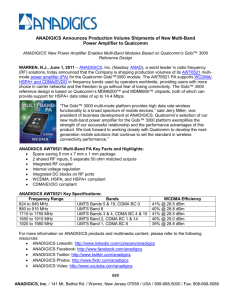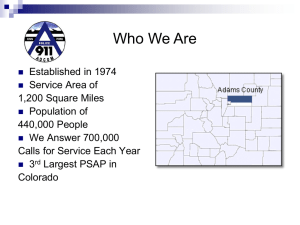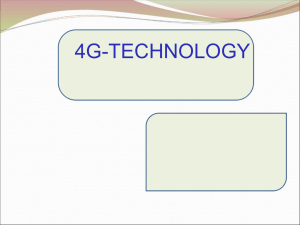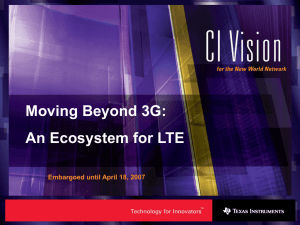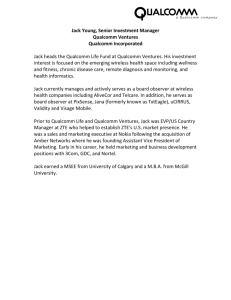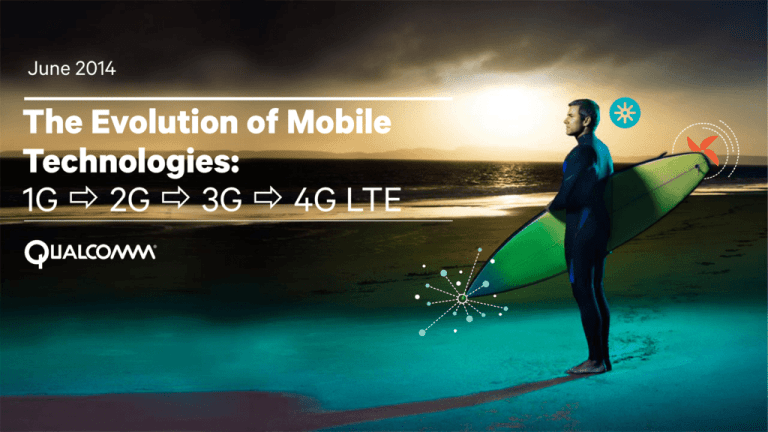
June 2014
The Evolution of Mobile
Technologies:
1G 2G 3G 4G LTE
1
The mobile experience is expanding everywhere
Billions of Mobile Connections
Billions of Mobile Experiences
“”
~25 Billion
Interconnected devices
forecast in 20202
~7 Billion
Mobile connections,
almost as many as
people on Earth1
>100 Billion
~270 Billion
App downloads
completed in 20133
App downloads
expected in 20173
2
1
Source: GSMA Intelligence, Apr. ‘14; 2 Source: Machina Research, ‘13; 3 Source: Gartner, Sep. ‘13
Mobile is an amazing technical achievement
Mind-blowing Performance
with processing power greater
than the most advanced super computers
of the early 1990s1
Jaw-dropping Graphics
1
4
Reliable Connectivity
All in a device
that fits in
your pocket
overcoming signal loss resulting in
receiving signal 100 trillion times weaker
than when it originated3
Broadband Speeds
with capability to process several
thousand megapixels per second2
with blazing fast data rates capable
of 300+ Mbps4
High Quality Multimedia2
Long Battery Life
4K UltraHD video player/recorder
HD gaming console
5.1/7.1 surround sound system
High resolution digital camera
with ability to power all these amazing
experiences with less energy than it takes
to power a light bulb for 15 minutes5
Source: Charlie White, Sep. '13 & giffgaff.com, Sep’13; 2 Based on latest Qualcomm® SnapdragonTM 800 series processors; 3 Based on >140 dB path loss typical in mobile;
Based on peak data rates for LTE Advanced; 5 Based on >2,000 mAh smartphone battery and >60W light-bulb
3
Connectivity is the foundation of a great mobile experience
Connect Reliably
Connect Real-Time
Get instant access to content with
less delay for “always-on” experience
Talk and browse without interruption
with more bars in more places
Connect On-the-Go
Talk and browse with seamless
mobility anywhere you get a signal
Connect Fast
Stream, surf, upload, and download
with fast, predictable data rates
Connect Longer
Go longer without plugging in
with improved battery efficiency
Delivering rich mobile broadband experiences
4
Powered by evolving mobile technologies for better experiences
Mobile 1G
Mobile 2G
Mobile 3G
Mobile 4G LTE
AMPS, NMT, TACS
D-AMPS, GSM/GPRS,
cdmaOne
CDMA2000/EV-DO,
WCDMA/HSPA+, TD-SCDMA
LTE, LTE Advanced
N/A
<0.5 Mbps1
63+ Mbps2
300+ Mbps3
Analog Voice
Digital Voice + Simple Data
Mobile Broadband
Faster and Better
Richer Content
(Video)
1
More
Connections
Peak data rate for GSM/GPRS, latest Evolved EDGE has peak DL data rates capable of up to 1.2 Mbps; 2 Peak data rate for HSPA+ DL 3-carrier CA; HSPA+ specification includes additional potential CA + use of multiple antennas, but no announcements to
date; 3 Peak data rate for LTE Advanced Cat 6 with 20 + 20 MHz DL CA; LTE specification includes additional potential CA + additional use of multiple antennas, but no announcements to date
5
Evolving mobile technologies deliver great mobile experiences
Appreciating the magic of mobile requires understanding the evolution from 1G to 4G LTE
1
1G established seamless mobile
connectivity introducing mobile
voice services
2
2G digital wireless technologies
increased voice capacity delivering
mobile to the masses
5
3
3G optimized mobile for data
enabling mobile broadband
services, and is evolving for faster
and better connectivity
4
4G LTE delivers more capacity for
faster and better mobile
broadband experiences, and is also
expanding in to new frontiers
Qualcomm has been at the forefront of this
evolution, pushing wireless boundaries to
enable the best mobile experiences
6
Mobile 1G established the foundation of mobile
1
2
3
Licensed Spectrum
Frequency Reuse
Mobile Network
Cleared spectrum for exclusive use
by mobile technologies
Reusing frequencies without interference
through geographical separation
Coordinated network for seamless
access and seamless mobility
PSTN
(landline)
Operator-deployed base stations
provide access for subscribers
Neighboring cells operate on different
frequencies to avoid interference
Integrated, transparent backhaul
network provides seamless access
7
Mobile 1G was amazing, but limited
Requires large gap of spectrum
between users to avoid interference
Support for only 1 user per channel
Spectrum is a finite resource like land; mobile spectrum is extremely valuable land (e.g., beach-front property)
Radio channels are like roads
built on this land to deliver voice
services to users
Frequency
Analog voice consumed
channel – 1 call per channel
8
1G analog voice was amazing, but limited
Limited Capacity
Limited Scalability
Analog transmissions are inefficient at
using limited spectrum
A
Analog devices are large/heavy, power
inefficient, and high cost
B
Frequency Division Multiple Access (FDMA)*
Large frequency gap required between users to avoid interference
B
A
30
kHz
30
kHz
30
kHz
30
kHz
30
kHz
30
kHz
30
kHz
30
kHz
Support for only 1 user (analog phone call) per channel
*
9
Example shown based on AMPS 1G technology
Mobile 2G digital technologies increased voice capacity
Delivering mobile voice services to the masses – more people, in more places
Mobile 2G
Mobile 1G
AMPS, NMT, TACS
D-AMPS, GSM/GPRS,
cdmaOne
Mobile for the Masses
More Voice Capacity
Foundation of Mobile
Seamless Mobility
1010110100111000
1980s
1990s
10
Early Mobile 2G technologies enabled more users per channel
STILL required large gap of spectrum
between users to avoid interference
Supported >1 user per channel
Frequency
Digital voice compressed
into smaller “packages”
Rigid delivery schedule whether or
not the user is actively talking
11
Mobile 2G digital wireless technologies enabled more users
Initial 2G technologies (D-AMPS, GSM) based on TDMA
More Voice Capacity
Scalable Technology
Digital transmissions enable compressed voice and
multiplexing multiple users per channel
Digital components cost/weight far less plus deliver
more secure signal
Voice Encoder
(Vocoder)
Compressed Voice Signal
8 kb per second
Uncompressed Voice Signal
64 kb per second
>1 user per radio channel
A
B
30 kHz
(pocket-sized)
C
Time
Time Division Multiple Access (TDMA)
Allows multiple users per radio channel with each user talking one at a time
12
Different Mobile 2G TDMA techniques were standardized
Only one user per radio channel
Mobile 1G (Analog)
User A
AMPS, NMT, TACS
Time
30
kHz
Mobile 2G (Digital)
Three users per radio channel
D-AMPS
Standardized as IS-54 by TIA in 1992
Mainly in North America
No longer utilized
A
30
kHz
Mobile 2G (Digital)
C
A
B
C
Time
Eight users per radio channel
GSM
Standardized by ETSI in 1990 (phase 1)
Initiated in Europe
Still widely used today (>4B connections WW1)
Simple data services with GPRS
B
A B C D E F G H A B C D E F G H
200
kHz
Time
13
1
Source: GSMA Intelligence, May ‘14
TDMA still required large frequency gaps to reduce interference
A
E
B
C
Channel 1
Channel 2
Channel 3
Channel 4
D
Channel 5
Frequency Gap
(not used in green cell)
Also required potentially
unreliable “hard” handoffs
Switch channels between adjacent
cells – potential for dropped calls
F
Channel 6
Channel 7
Channel 8
14
CDMA utilizes all the available spectrum to support more users
Ability to support many
more users (>10x
1G)
CDMA
with same spectrum
Utilize all available
spectrum
Frequency
Each users
information
coded with
unique code
No rigid delivery schedule –
delivery truck can take
advantage of when user is not
talking to support more callers
15
Qualcomm solved the seemingly impossible wireless challenge
CDMA enables users to share the same frequency and communicate at the same time
At the Receiver
At the Transmitter
User A
Spread using Code A
User A
User B
+
Spread using Code B
User B
User C
+
Spread using Code C
User C
Code Division Multiple Access (CDMA)
Multiple users can talk at same time using
different languages (“codes”)
Reconstruct using
Code A
Other signals
look like noise
Reconstruct using
Code B
Reconstruct using
Code C
Voice Voice
Voice Voice Voice
Voice
Voice
Voice
Voice
Voice
Voice
Voice
Voice
Voice
1.25 MHz
16
Qualcomm solved complex challenges to commercialize CDMA
1
2
3
Near-Far Power Challenge
Cell-Edge Challenge
Multipath Fading Challenge
Users close to the tower overpower
the uplink signal minimizing capacity
on the shared channel
Interference caused by users in close
proximity, on the same frequency, and
communicating with different towers
Interference caused by the reception of
the same signal over multiple paths
resulting in poor signal-to-noise ratio
Solution:
Continuous control of transmit
power based on signal strength
Solution:
Users simultaneously communicate
with multiple towers at cell edge
Solution:
Advanced (“rake”) receivers combine
energy of multiple signal paths
Path A
A
B
Path B
User A
Up to 1,000,000 X
+
Path C
User B
User A
User B
Without Power Control
Signal Power at Tower
With Power Control
Signal Power at Tower
+ Soft (vs. Hard) Handoffs
Additional benefit of simultaneous
connections – more reliable handoffs
Signal Strength
at Receiver
Noise
17
CDMA delivered unprecedented voice capacity and much more
Qualcomm efforts lead to new CDMA standard (IS-95) referred to as cdmaOne
CDMA Timeline2
CDMA Benefits
Increased voice capacity by several times
~14x
February 1990
Provided more efficient use of spectrum resources
First CDMA field trial completed by
Qualcomm and NYNEX
Increased battery life in mobile devices
March 1992
Better security with CDMA encoding
Standards committee formed in
Telecommunications Industry Association
May 1995
IS-95 revision A (cdmaOne) released
Reference
(1x)
Analog
1980s
December 1995
~3x
First commercial deployment
December 1999
GSM
1990s
cdmaOne
1990s
Potential Voice Capacity Improvements1
cdmaOne subscribers pass 50 million
worldwide (>80 operators in >30 countries)
CDMA is the foundation for
Mobile 3G technologies
18
1
Approximate total number of subscribers serviced within same spectrum based on AMPS (1G), GSM and cdmaOne technology commercial deployed in 1990s; 2 Source: CDG, www.cdg.org
CDMA established the foundation for 3G technologies
Mobile 3G evolved into two competing standards both based on CDMA
IS-95 (cdmaOne)
CDMA2000
EV-DO (Evolution-Data Optimized)
Initial CDMA standard
from Qualcomm
Uses 1.25 MHz carrier;
easy migration from cdmaONE
Optimized data channel for CDMA2000
providing mobile broadband services
May 1995
July 2000 (Revision A)
October 2000 (Release 0)
WCDMA (UMTS)
HSPA (High Speed Packet Access)
Evolution
Uses 5 MHz carrier;
leverages GSM core network
Optimized data channel for WCDMA
providing mobile broadband services
Influenced
June 2001 (Release 99)
June 2004 (Release 5)
19
Note: ITU IMT-2000 compliant 3G standards included EDGE, TD-SCDMA, and WiMAX; CDMA2000 and WCDMA were the most commercially successful
Mobile 3G evolved mobile for data
Introducing high-speed internet access for the first time
Mobile 3G
Mobile 2G
Mobile 1G
AMPS, NMT, TACS
D-AMPS, GSM/GPRS,
cdmaOne
CDMA2000/EV-DO,
WCDMA/HSPA+, TD-SCDMA
Mobile Broadband
Data Optimized
Mobile for the Masses
More Voice Capacity
Foundation of Mobile
Seamless Mobility
1010110100111000
1980s
1990s
2000s
20
Mobile voice was amazing, but consumers wanted more
A new, insatiable demand for internet access and data services emerges
Broadband Internet
The Smartphone
Mobile Everywhere
2 39 92
1990
2000
2010
Average mobile subscriptions
per 100 people1
Consumers introduced to broadband internet
access in the home/office
1
Source: Worldbank.org for United States
Amazing innovations in device technology
resulted in the era of the smartphone
Thanks to 2G technologies, more and more
people had a mobile subscription
21
EV-DO optimized 3G for data enabling mobile broadband
Data Enabled
Data Optimized
Simple Data Services
Mobile Broadband
Mobile 2G
CDMA2000/EV-DO
<0.5 Mbps1
14.7 Mbps2
Text
Capable of
efficiently
supporting small
data files
1
2
Based on peak data rate – GSM/GPRS
Based on peak data rate for downlink EV-DO Rev. B
+
Email
CDMA2000
Voice Services
EV-DO
Data optimized channel with
support for larger package sizes
22
Qualcomm pioneered EV-DO introducing mobile broadband
Mobile 2G
CDMA2000/EV-DO
Mobile 3G
Data Enabled
Data Optimized WCDMA/HSPA
Data Optimized
1.255 MHz
1.25 MHz
1.25 MHz
Voice
Voice
Voice
Voice
Voice
Voice
Voice
Data
Voice
Voice
Data
Data shared with
voice-optimized
radio channel
Data
Data
Data
Voice Voice
Voice
EV-DO blazed
Voice Voice
Voice
the trail
for Voice
Voice
Voice
VoiceHSPA
Voice
Voice
Voice
Voice
CDMA2000
Voice
Data
Data
Voice
Voice Introduction of a
Voice Voice
Voice Voice
data-only, dataVoice Give all resources
to
one user at a time Voice optimized channel
Voice
(data optimized)
After voice users served,
Voice
remaining resources used
Voice
EV-DO
for data based
on same
principles as EV-DO
Voice
Voice
Text
Headlines
Email
Simple Data Services
Multimedia
WWW
Browser
Navigation
Mobile Broadband Services
Apps
23
EV-DO inventions are the foundation to mobile broadband
1
2
3
Data Optimized Channel
Adaptive Modulation
Opportunistic Scheduling
Splits channel into time intervals
enabling a single user to get all the
resources at once
Uses higher order modulation to
get more bps per Hz for users with
good signal quality
Enables richer content
Increases peak data rates
Optimizes channel by scheduling
users at the time instances when
users have good radio signal
conditions (with fairness)
Increases overall capacity
Higher Data Rates
Data
Optimized
Cell Edge
Power
Resources
Lower Data Rates
Time
User A
User B
24
CDMA2000/EV-DO blazed the trail for WCDMA/HSPA
CDMA2000/EV-DO
1.25 MHz
Voice Voice
Voice Voice Voice
Voice
Voice
Voice
Voice
Voice
Voice
Voice
Voice
Voice
CDMA2000
WCDMA/HSPA
1.25 MHz
5 MHz
Voice
Data
Give all resources to
one user at a time
(data optimized)
EV-DO
Voice
Voice
Voice
Voice
Voice
Voice Voice
Data
Voice
Voice
After voice users served,
Voice
remaining resources used
Voice
for data based on same
principles as EV-DO
Voice
Voice
25
Mobile 3G evolved to HSPA+ and EV-DO Rev. B
Delivering higher data rates, more capacity, and enhanced mobile broadband experiences
Higher Order Modulation (HOM)
Carrier Aggregation
Introduces 64-QAM enabling 50% more
bits per second per Hz (bps/Hz)
Aggregating spectrum enabling increased
user and peak data rates
111
011
101
110
010
Carrier #1
000
Carrier #2
Carrier #3
Aggregated
Data Pipe
Enabling packing 50% more
data into packages
Aggregate channels for higher data rates
26
3G technologies optimized mobile for data
Mobile Broadband Timeline1
EV-DO and HSPA Benefits
1999
Delivered achievable throughput >2 Mbps
Series 1
14.4 Mbps
63+ Mbps
Qualcomm introduces EV-DO
January 2002
Reduced operator cost for data services
First EV-DO commercial launch
Continuous evolution for enhanced services
Q4 2004
HSPA+
Q1 2007
3.1 Mbps
14.7 Mbps
0.5 Mbps
Rev. B
<0.5 Mbps
Mobile 2G
GSM / GPRS
EV-DO passes 50 million connections
Q108
HSPA passes 50 million connections
HSPA
CDMA2000 / EV-DO
Peak Data Rate
(Mbps)
June 2008
First HSPA+ (21 Mbps) commercial launch
Rev. A
Mobile 3G
3GPP release 6 with HSPA is published based
on WCDMA technology
Mobile 3G
WCDMA / HSPA
September 2010
First DC-HSPA+ (42 Mbps) commercial launch
3G technologies continue to evolve
Surpassed 2B connections in 20132
27
1
Source: CDG (www.cdg.org) and 3GPP (www.3gpp.org); 2 Source: GSMA Intelligence, May ‘14
Mobile 4G LTE is evolving to provide more data capacity
Delivering faster and better mobile broadband experiences
Mobile 4G LTE
Mobile 3G
Mobile 2G
Mobile 1G
AMPS, NMT, TACS
D-AMPS, GSM/GPRS,
cdmaOne
CDMA2000/EV-DO,
WCDMA/HSPA+, TD-SCDMA
LTE, LTE Advanced
Faster and Better Mobile Broadband
More Data Capacity
Mobile Broadband
Data Optimized
Mobile for the Masses
More Voice Capacity
Foundation of Mobile
Seamless Mobility
1010110100111000
1980s
1990s
2000s
2010s
28
Mobile 4G LTE complements 3G to boost data capacity
Multimode 3G/LTE is the foundation for successful 4G LTE
4G LTE
Providing more data capacity for richer content and more connections
Multimode
3G
LTE FDD/TDD
WCDMA/HSPA+
CDMA2000/EV-DO
TD-SCDMA
GSM/GPRS
Enabling a consistent broadband experience outside 4G LTE coverage
Delivering ubiquitous voice services and global roaming
29
Mobile 4G LTE delivers more data capacity
Flexible support for wider channels
supporting more users
Create spatially separated
paths with more antennas
Aggregate channels for higher
data rates
30
Mobile 4G LTE delivers more data capacity
Download, browse, stream, and game faster than ever with faster and better connectivity
Carrier #3
Carrier #1
Connect
Faster
Connect
Real-time
1
As of May 2014
Carrier #4
Carrier #2
Carrier #5
Wider Channels
Flexible support for
channels up to 20 MHz
enabled with OFDMA
Aggregated
Data Pipe
Up to 100 MHz
More Antennas
Carrier Aggregation
Advanced MIMO techniques to
create spatially separated paths;
2x2 MIMO mainstream
Aggregate up to 100 MHz for
higher data rates – 2 carrier (2C)
commercial; 3C announced1
Simplified Core Network
Low Latencies
All IP network with flattened
architecture resulting in less
equipment per transmission
Optimized response times for
both user and control plane
improves user experience
31
Mobile 4G LTE is the first global standard for mobile broadband
LTE FDD & LTE TDD
Global LTE network launches
279
Launches
101
Countries
Large device ecosystem
1,563
Devices
>100
Vendors
Two modes, common standard, same ecosystem
Spectrum 1
Uplink (UL)
Spectrum 2
Downlink (DL)
Frequency Division Duplex (FDD)
Paired spectrum enables
better coverage
Spectrum
UL
DL
UL
Time
DL
Time
Time Division Duplex (TDD)
Unpaired spectrum enables asymmetrical
DL/UL for more DL capacity
Source: GSA, Mar. ‘14
32
Mobile 3G and 4G technologies
continue to evolve to deliver
faster and better mobile
broadband experiences
33
Mobile 3G and 4G LTE continue to evolve
Delivering a faster and better mobile broadband experiences
4G LTE has evolved to LTE Advanced
Providing more data capacity and expanding into new frontiers
Rel-8/9
Rel-10
Rel-11
Rel-12 & Beyond
LTE Advanced
LTE
3G networks have continued to evolve and improve—so much so some call it 4G
Providing a consistent broadband experience outside LTE coverage
Rel-7/8
HSPA
Rel-9
Rel-10
HSPA+
HSPA+
Rel-11
Rel-12 & Beyond
HSPA+ Advanced
Rel-12
WCDMA+
WCDMA
Rev A
Multicarrier
EV-DO
EV-DO Rev. B
Phase II
Phase I
DO Advanced
Voice Efficiency
CDMA2000 1X
Commercial
M2M Efficiency
1X Advanced
34
Shared
Resources
Mobile 3G/4G technologies are evolving for more data capacity
HSPA+
Evolution
HSPA+
HSPA
Shannon’s Law
𝐶 ≈ 𝑊 ∙ 𝑛 ∙ log 2 (1 + 𝑆𝑁𝑅)
Capacity
Spectrum
More
Spectrum
Antennas
Signal Quality
More
Antennas
Interference
Mitigation
Advanced multiple antenna
techniques to create spatially
separated data paths, e.g., 4 way
receive diversity, 4x4 MIMO
Advanced receivers and antenna
techniques, e.g., LTE FeICIC/IC,
HSPA+ advanced device receiver
~3.5 GHz
& ASA
Making the best use of all spectrum
types with more licensed spectrum
as the top priority, e.g., ASA, ~3.5
GHz, unlicensed spectrum
35
LTE Advanced is evolving and expanding into new frontiers
~3.5 GHz
& ASA
Extending LTE Advanced
to unlicensed spectrum
Dynamic LTE broadcast. Going
beyond mobile for terrestrial TV
LTE Direct for continuous
device to device proximity
awareness
Higher spectrum bands
new licensing models—
Authorized Shared Access
36
Qualcomm is the leader in Mobile 3G/4G technologies
Each modem generation enhances user experience and provides more capacity
First LTE Advanced
Increasing User Experience
First Integrated LTE Multimode
DL: 100 Mbps
Higher efficiency (LTE)
2 x 2 MIMO
Support for 3G and 4G technologies
First Integrated
LTE
Smartphone
First LTE
World
Mode
First World Mode LTE
Advanced Modem
with 60 MHz CA and CAT6
DL: 300 Mbps
60 MHz Carrier Aggregation
DL: 150 Mbps
20 MHz Carrier Aggregation
First 3C-HSPA+
First DC-HSPA+
First HSPA+
First HSUPA
DL: 42 Mbps
UL: 11 Mbps
2 Carrier Aggregation
DL: 63 Mbps
UL: 11 Mbps
3 Carrier Aggregation
DL: 28 Mbps
UL: 5.76 Mbps
Higher Order Modulation
2 x 2 MIMO
DL: 7.2 Mbps
UL: 5.76 Mbps
Enhanced Uplink Channel
First HSDPA
DL: 1.8 Mbps
UL: 384 kbps
Higher Order Modulation
Time
Qualcomm® GobiTM is a product of Qualcomm Technologies, Inc.
37
Qualcomm is the leader in Mobile 3G/4G technologies
Hiding the complexity underneath the most seamless mobile connectivity
The Unique Qualcomm Advantage
LTE
FDD
EV-DO
LTE
TDD
GSM/
GPRS
HSPA+/
WCDMA
All major Cellular Standards
+Standards Evolution
CDMA
1X
TDSCDMA
700/
850/900
1500/
1700/1900
~40 RF Bands
17 LTE Voice Modes
2300/
2600
Wi-Fi
Position
BT
Wi-Fi, Positioning,
BT(Bluetooth)
Supports all technologies, bands, modes, …
Qualcomm® GobiTM is a product of Qualcomm Technologies, Inc.
38
Evolving mobile technologies deliver great mobile experiences
1
1G established seamless mobile
connectivity introducing mobile
voice services
2
2G digital wireless technologies
increased voice capacity delivering
mobile to the masses
5
3
3G optimized mobile for data
enabling mobile broadband
services, and is evolving for faster
and better connectivity
4
4G LTE delivers more capacity for
faster and better mobile
broadband experiences, and is also
expanding in to new frontiers
Qualcomm has been at the forefront of this
evolution, pushing wireless boundaries to
enable the best mobile experiences
to learn more, go to: www.qualcomm.com/wireless
39
Questions? - Connect with Us
www.qualcomm.com/technology
BLOG
http://www.qualcomm.com/blog/contributors/prakash-sangam
@Qualcomm_tech
http://www.youtube.com/playlist?list=PL8AD95E4F585237C1&feature=plcp
http://www.slideshare.net/qualcommwirelessevolution
http://storify.com/qualcomm_tech
40
Thank you
Follow us on:
For more information on Qualcomm, visit us at:
www.qualcomm.com & www.qualcomm.com/blog
© 2014 QUALCOMM Incorporated and/or its subsidiaries. All Rights Reserved.
Qualcomm is a trademark of Qualcomm Incorporated, registered in the United States and other countries.
Other products and brand names may be trademarks or registered trademarks of their respective owners.
References in this presentation to “Qualcomm” may mean Qualcomm Incorporated, Qualcomm Technologies, Inc., and/or other subsi diaries or business
units within the Qualcomm corporate structure, as applicable. Qualcomm Gobi is a product of Qualcomm Technologies, Inc.
Qualcomm Incorporated includes Qualcomm’s licensing business, QTL, and the vast majority of its patent portfolio. Qualcomm Te chnologies, Inc., a
wholly-owned subsidiary of Qualcomm Incorporated, operates, along with its subsidiaries, substantially all of Qualcomm’s enginee ring, research and
development functions, and substantially all of its product and services businesses, including its semiconductor business, QC T.
41

